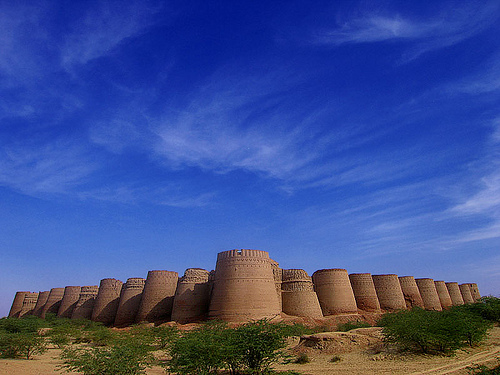

Location: Jaisalmer, Rajasthan state Map
Constructed: 1156 AD
Jaisalmer Fort also known as a Golden Fort is a medieval fortress situated in a town of Jaisalmer in Rajasthan state in India. It was constructed in 1156 AD by Bhati Rajput ruler Rao Jaisal.
The style
The Jaisalmer Durg Muslim style is particularly distinct from Mughal
architecture. There is a complete lack of mausoleum forts, gardens,
gardens, canals and fountains etc. Like the fort of Chittau, there
are palaces, temples, administrators and houses for the common
people, which are still the residence of the common people. Is the
site.
Architecture
Jaisalmer fort is made of huge blocks of yellow stones. No lime or
mortar has been used anywhere in the fort. Only by placing stones on
a stone or by placing a slot, it is kept. At the foot of the fort's
foothills is a 15 to 20 feet high percussion percot, followed by a
percot at a height of 200 feet, which is 10 to 156 feet high. In
this park, huge boulders and cylindrical huge stones are placed
between the kangurs for running cannon and gun. The use of round and
cylindrical stones rolled from the lower wall and rolled over the
enemies coming up, there were large artisans in the casualties,
after the war, they were brought back to their place. The other wall
is similar to the east wall 5 to 10 feet high of this coat. There
are 4 bastions built in this wall. These bastions were built much
later by Maharawal Bhima and Mohandas. In the open upper part of the
bastion, huge jungles are made for firing cannon and guns. There are
rooms under the turret, which used to be temporary accommodation of
soldiers and storage of weapons in the time of war.
The outside of these rooms are made of swinging balcony, they were
used to covertly monitor and monitor the movements of the enemy
during the war. The construction work of these 4 bastions was
started in the time of Rawal Jaisal, with its successors continuing
the continuation of Shalivahana (1190 to 1200 AD) Jait Singh (1500
to 1526 AD) Bhima (158 to 1413 AD) Manohar Completed at the time of
Das (1826 to 1750 AD). In this way, the style of construction work
of many centuries is visible in the construction of the fort.
The gate
The name of the chief of the fort is Akhapola, which was built by
Maharawal Akhasingh (1622 to 1772 AD). It has been built with a very
large hallway outside the main gate to the east of the fort. Due to
this, the main gate of the fort could not be attacked immediately.
The second main gate of the fort was rebuilt by Rawal Bhima. In
addition to this is the Barisal Burj located in front of this door,
it has been made in such a way that the fort is covered by its main
and the space in front of the door has become so narrow that a large
number of enemies could not enter it. Neither could the gate of the
fort be broken with the help of elephants. Apart from this, seven
other bastions were also built by Bhima in the fort. At that time
Rawal Bhima spent 50 lakhs in all these works. Regarding the system
of fortification from a strategic point of view, Rawal Bhima's
statement was that the second person can answer the sitting in the
field and Delhi's rich can not remain such a stronghold.
The third door of the fort is Ganesh Pol and the fourth door is
known as Rangpole. All doors are rebuilt by Rawal Bhima. As the sun
rises, we find the Rancho Temple, which was built by Maharaval Akha
Singh's mother in 171 AD. The Suraj-Pol is built by Maharawal Bhima.
Above the arch arch of this door is the shape of the sun.
The fort has many palaces, temples and other various buildings used
by various kings. Jaisalmer Fort has around 400 houses built with
yellow stones of • Hazuri Samaj and • Brahmin Samaj, which are up to
three storeys. The front part of these houses has beautiful carved
windows and windows. To further strengthen the defenses of the fort,
the Bhati rulers built a wall around this fort and built four proles
leading in all directions • Amarsagar Prol • Gadisar Prol •
Kishanghat Prol • Malka Prol which is still used in the outer areas
of the city. It works by connecting with.
Palace
Among the palaces located in the fort, Malia of Harraj is the best
Vilas, Rangmahal, Motimahal and Gajvilas etc. are prominent.
Sarvottam Vilas is a very beautiful and magnificent building, which
has very beautiful inlay of blue ceramic tiles of Central Asia and
European imported glass. This building was built by Maharawal Akha
Singh (1822-72). It is currently known as Sheeshmahal. This palace
is also known as "Akhavilas". A palace was built in the upper part
of Hawapol by Maharawal Moolraj II (182–1420 AD). It has a huge hall
and hallway. The walls have very beautiful carvings and are a
perfect symbol of the inlay work of glass. It is three storeyed,
with a large chamber of the Raj Sabha on the first floor. On the
second floor there are open ceilings, some rooms and snip-covered
Baradaris with beautiful vents. The structure and architecture of
Jaisalmer fort and the grand palaces, buildings, temples etc. built
there give it even more grandeur. This fort built with yellow stones
gives the impression of a golden fort from a distance.